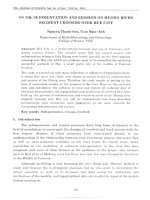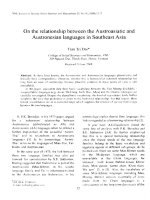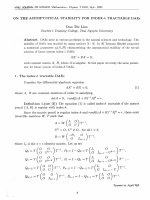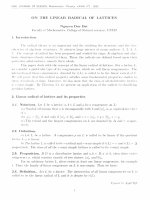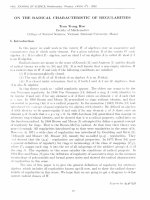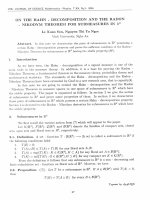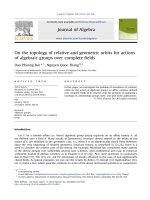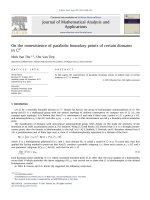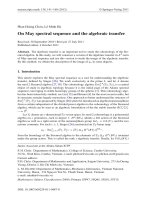DSpace at VNU: On the Hahn - Decomposition and the Radon - Nikodym Theorem for Submeasures in Rd
Bạn đang xem bản rút gọn của tài liệu. Xem và tải ngay bản đầy đủ của tài liệu tại đây (3.98 MB, 13 trang )
V N U . J O U R N A L O F S C IE N C E , M a t h e m a t i c s - Physics.
T.xx,
N q 3 - 2004
ON T H E H A H N - D E C O M P O S IT IO N A N D T H E R A D O N
-
N IK O D Y M
THEOREM
F O R S U B M E A S U R E S IN R D
Le X u a n Son, N g u y en T h i Tu N goc
Vinh University, N ghe An
A b s t r a c t . In this note we characterize the pairs of submeasures in R d possessing a
certain Hahn - decomposition property and prove the sufficient condition of the Radon Nikodyrn Theorem for submcasures in 1R^ having the stable propcĩty (SP).
1.
In tro d u c tio n
As we have seen, the H ah n - decom position of a signed measure is one of the
main tools in the m easure theory. In addition, it is a base for proving the Radon Nikodym Theorem , a fundam ental theorem in the measure theory, probability theory and
m athem atical statistics. T h e sta n d a rd s of the H ahn - decomposition and the Radon Nikodym T heorem have been extended by G raf to a new research area, th a t is capacity[4],
In this note we are going to extend the Hahn - decomposition and the Radon
- Nikodym T h eo rem in m easure spaces to one space of submeasures in R d which have
the stable property. T h e p ap er is organized as follows. In section 2 we give the notion
of submeasure in w l and prove some properties of them. In section 3 we characterize
those pairs of subm easures in R d which possess a certain Hahn - decomposition property.
Section 4 is devoted to the R adon - N ikodym derivaties for submeasures in R which have
the stable property.
2.
S u b m e a s u r e s in R d
We first recall the various notion from [7] which will appear in the paper.
Let JC(Rd)
Ợ(Ká ) an d B{K d) denote the families of compact sets, closed
sets, open sets and Borel sets in R d, respectively.
2.1. D e f i n iti o n . A set - function T : ổ ( E d) — * [0;oo) is called a submeasure in
if
the following conditions hold:
1
T(0) = 0;
2.
3.
4.
T ( A U 5 K T (A ) + T ( B ) for any Borel sets A ’ B]
T ( A ) = s u p { t \ k ) : K € IC{Rd) , K c A } for any Borel set A e B{ Rd)]
T { K ) = in f{ T { G) : G € G{ Rd), G D K } for any compact set K € £ ( R d).
From the definition it follows t h a t any submeasure in R d is a non - decreasing and
finite subadditive set - function on Borel sets of R d. Morever, we have
2.2. P r o p o s i t i o n . ([7]). L et T be a subm easure in R d. I f A e B { R d) with T ( A ) = 0,
T(B) = T ( A u B )
for every B € B (R d).
Typeset by
37
38
Le X u a n S o n
,
N g u y e n T h i Tu N g o e
2.3. P r o p o s i t i o n . ([7]). A n y capacity is upper sem i - continuous on compact sets,
j.e, if K ị D K 2 D - D K n D • - • is a decreasing sequence o f com pact sets in R d and
fìn = i K n = K , then lim T ( K n ) = T ( K ) for a ny capacity T .
2.4. P r o p o s i t i o n .
A n y submeasure is lower semi - continuous on open sets, j.e, i f
G\ c Ơ 2 c • • • c Gn c • • • is a increasing sequence o f open sets in R d and U ^Li G n = Ơ,
then lim T ( G n ) — T ( G ) for any submeasure T .
n —>oo
Proof. For given € > 0, by (3.)
/C(Rd) , / i c G such th a t
in the definition of subm easures, there exists i f e
T( K ) > T(G) -
6.
We claim that, there exists no e N such th a t
K c Gn
for every
n > ĨÌQ.
Indeed, assume, on the contrary, th a t K \ Gn 7^ 0 for all n. Since K is a com pact set and
G n are open sets, { K \ G n } is a decreasing sequence of non - void com pact sets. Hence
f | ( A : \ G n) = A ' \ ( 0 G n ) = K \ G ạ ự )
n1 == 11
n=l
giving a contradition to K c G. T h e claim is proved. It follows
T( Gn) > T ( K ) > T(G) — 6, for every n > no
Therefore
lim
n —>oo
r(G„) >
T ( G) - €.
Since e is arbitrary, then we have
lim T { G n ) > T ( G ) .
n —>oo
Combinating the last inequality with T ( G) > lim T ( G n ) we get
Tl—>00
lim T ( G n ) = T ( G ) .
71—>00
The proposition is proved.
From Proposition 2.4 we have the following corollary
O n the H a h n - d e c o m p o s i t i o n a n d th e R a d o n - N i k o d y m T h e o r e m f o r ...
2.5.
C o ro llary .
39
A n y subm easure T in R d possesses the countable subadditivity on
ỡ ( R d) and K ( R d).
Proof. Firstly, let {Gn }^°=1 be a sequence of open sets in R d and let T be a capacity in
W L. For 77, G N, set
Bn = [ j G k.
k= 1
Then { 5 n }J°_i is a increasing sequence of open sets and U^Li Bn — UÍT=1
by Propo
sition 2.4 we have
T(U~=1Gn) = r ( u ~ =1£ n) = l i m T ( B n) = lim r ( U Ĩ =1Gfc)
71—»00
71—>00
n
oo
< lim ( £ r ( G * ) ) = £ r ( G „ ) .
k = 1
71
n = l
We will show t h a t T has Ơ - subadditive pro perty on /C(Rd). Let { K n } ^ =1 be a sequence
of compact sets in R d. Given € > 0, for every n, by (4.) in definition of submeasures, there
exists Gn € Ợ(Kd) such t h a t Gn D K n and
T ( G n) < T ( K n) + Ặ .
Hence
oo
oo
oo
oo
^
T( u K n) ^ T ( \ j G n) < Y ^ T ( Gn) < Y ^ ( T ( K n) + ỳ )
n= l
71= 1
71=1
71= 1
= f ] T ( K n ) + e.
n=1
Since e is arbitrary, we get
T { \ j K n) ^ f ^ T ( K n).
n=l
3.
n=l
T h e H a h n - d e c o m p o s i t i o n fo r S u b m e a s u r e s in R d
3.1. D e f i n i t i o n a l ) . Let S , T : B ( R d) — -> R + be submeasures in R d .
(a) T h e pair ( S ,T ) is said to possess the weak decomposition property^W D P ) if, for
every a e K + , th ere exists a set A a e B ( R d) such th a t
a T Aa < S Aa and a T A% > S Aị ■
.(b) T h e pair ( S ,T ) is said to possess the strong decomposition property^SDP) if, for
every a € R + , there exists a set A a 6 5 ( R d) such th a t the following conditions
hold:
40
Le X u a n S o n , N g u y e n T h i Tu N g o e
(i) For A, B e B( Rd); D c A c A a implies
a(T(A)-T(B))^S(A)-S(B).
(ii) For A e ổ(Rd); a ( T( A) - T ( A n A a )) > S ( A ) - S ( A n Ả Q).
Observe th a t (SDP) implies (W D P) and if ( S , T ) possesses (W D P ) then so does
( T, S ) (see [4]).
3.2. D e f in itio n . Let T : B(Md) — > R+ be a subm easure in R d. T is said to possess
stable property{SP) if, for any sequense of Borel sets { A n } c B ( R d) satisfies T ( A n ) = 0 for
every n, then T ( ( J ^ =1) = 0. By Co we denote the family of all subm easures in R d which
possess SP.
The following result is proved by G raf([4]) for th e subm easures w ith the lower semi
- continuous property. Here we will prove for the capacities in
which possess the SP.
Note th a t the lower semi - continuity implies the Ơ— su bad ditivity which implies the SP.
3.3. P r o p o s i t i o n .
A ssu m e that S , T E Co. Then the following conditions are equivalent:
(i) (S,T) has WDP.
(ii) There exists a Dorel measurable function f : R d — > [0; -f-oo] such that
a T {f><*} < s u ><*} a n d a T { / < a } >
(1)
for every a e R + .
Proof, (ii) => (i). Let / be a Borel measurable function satisfying (1). For each a e R+,
set
A a = { f > a}.
Then we have
a T Aa ^ S a q and a T Ac > S ac .
It means that (5, T ) has the WDP.
(i)
=» (ii). For each a 6 1R+ let A a be as in th e definition of th e W D P. A decreasin
family { B a : a £ R + } is defined as follows.
Bo = R d ; Bot = r){A (3 ; /3 6 Q ( a )} for every a > 0,
where Q (a ) = [0; a) n Q (Q denotes the set of all rational num bers). We define a function
/ : R d — » [0; 4-oo] by G ra f’s formular :
f ( x ) = su p { a; X e B a }.
We will show th at
Bet — { / >
ol]
for every a E
.
(2)
Indeed, a > 0 then, by the definition, X G B a implies f ( x ) > a. Conversely, if X 6 { / > a}
then, for every p e Q (q ), there exists a ' G (/?, a ) n Q w ith X G B a'. T h u s we deduce X G Ap.
Since /3 E Q (a) is arbitrary we obtain
x e n { A (3]p e Q { a ) } = B a .
On the H a h n
-
d e c o m p o s i t i o n a n d the R a d o n
-
N ikodym Theorem for...
Since Bo — { / > 0} our claim is verified. Because B a £ B ( R d) for every a E
function / defined above is also Borel measurable.
Next we will prove t h a t
S ( A a n A%) = T ( A a n ^ ) - 0 for all ử , / 3 g R + with p < a.
41
the
(3)
From the definition of A a an d A p we deduce
a T ( A a n i4^) < S ( A a n Ap) < (3T(Aa n A£).
This inequality implies
T( Aa n A ^ ) = o = S( Aa nA^ ) .
We claim th a t
a T {f ><*} ^ 5 { / > a } fo r e v e r y a 6 K + -
If a = 0 then there is noth ing to show. For a > 0, let B c { / > a } , B € B { R d). For every
f3 e Q (a ) we have D c Ap, therefore 0 T ( B ) < 5 ( B ) . Since /3 e Q ( a ) is arbitrary then
qT (B )
< 5(5 ).
T h a t means t h a t (4) is proved.
To complete the proof of (i) =»(ii) we will show th a t
cí T ịịc
> S
b
° for e v e r y a e R + .
(5)
If a = 0 this inequality is satisfied by th e definition of Do. For a > 0 let B € B ( R d) with
D n B a = 0 be arbitrary. We have
D = [D n (u /3ểq (q) ^ ) ] Ị J [b n (U/jgQ,(a)Ap) ]
=
[u /JGQ(a) { B n A %) ] u
[B n ( n 0 e Q ( « ) 4 f O ] =
u
(B n A P)•
(6)
PeQ(a)
Because 5 possesses th e SP an d by (3), it follows
s (uiaeQ(Q)(B n Aa n Ap)) ^ s (U/3 gQ(Q)(Aa n Ap)) = 0.
(7)
From (6), (7) and s e Co we get
S{B) ^ S { B n A a) + S ( B n A ca )
= 5 [(u0€Q(a){B n Ap)) n Aa] + S(D n Aca )
= s (up£Q(a){B n Aa n Ap)) + S(B n Aca )
= S ( D n A ac ) ^ a T ( B n A ị ) ^ a T ( B ) .
(5) is proved.
3.4. D e f i n i t i o n . Assum e t h a t 5 , T G Co(a) If (5, T ) has th e W D P th en every Borel measurable function / : R d — » [ 0 ,+ 00 ]
such th a t (1) is satisfied is called a decom p osio n fu n c tio n o f ( 5 , T ) .
(b) Two Borel m easurable functions / , g : R d — * [0,-foo] are called T — equivalent if
T ( { f / g } ) = 0.
T hen we have
42
Le X u a n S on , N g u y e n T h i Tu N g o e
3.5. P r o p o s i t i o n . Let 5, T E Co and (5, T) has the W D P . Then any two decomposition
functions o f (5, T) are S '- an d T - equivalent.
Proof. Let / , g :
— » [0,+oo] be decomposition functions of ( 5 , T). For p ,q E Q + =
Q n R + with p < q we define
= {/ < p } n { 5 > (?}.
It is clear th at
{ / < < ? } = U{ẨPi9 ; p , q e Q +, p < q}.
By Proposition 3.3 we have
q T ( A p
T ( A P,q) = 0 = S ( A PiQ) for p, q € Q + , p < Since 5, T possess the SP, we get
S { { f < g}) = s (u{Ẩp,q ; p, q e Q + , p < q}) = 0,
T ( { f < g} ) = T (u{Ap,9 ; p, q e Q + , p < q}) = 0.
Exchanging the role of / and g leads to
S ( { g < / } ) = T( { g < / } ) = 0.
Therefore,
S ( { f + g}) < S ( { f < g}) + S( { g < / } ) = 0,
T ( U ± 5 » < T ( { f < 5» + T({g < / } ) = 0.
Hence f , g are S — and T — equivalent.
The following proposition is proved by Graf for the set - functions with th e monotone
property and the finite su bad d itive property so it is true for th e su bm easures in R d .
3.6. P r o p o s i t i o n . Let 5, T : B ( R d) — »
be submeasures in R d. Then (5, T ) has the
SD P if only if the following holds :
(i) (S ,T ) has the WDP.
(ii) For every a G
for every A 6 B ( R d) with clT a ^ S a , an d for every B G B ( R d)
with B c A the inequality
a(T(A) - T{B)) ^ S(A) - S(B)
is satisfied.
On the H a h n - d e c o m p o s i t i o n a n d the R a d o n - N i k o d y m T h e o r e m f o r . . .
(Hi) For every a E
43
6 B ( R d), and B 6 B ( R d) with D c A , 0ÍTb ^ 5 b , olT^\b >
S a \ b the inequality
a(T(A) — T(B)) > S(A) — S(B)
is satisfied.
The following example is a pair of submeasures which possesses the W D P but does
not have the SDP.
3.7.
E x a m p l e . Let S , T : B{R) — > R + be set - functions are defined by
f 0 if A = 0
S(A) = < 1 if i ị A^ự)
( 2
if 1 e A
and
( 0 if -A—0
T{A) = < 2 if [0,1] c
[ 1
i4
otherwise.
Then 5, T have the following property:
(i) S , T e C 0.
(ii) T is not lower semi - continuous.
(iii) (S, T) has the WDP, b u t
(iv) (5, T) does not have the SDP.
Proof, (i). It is easy to see th a t S , T satisfy the conditions (1.) - (4.) in the definition of
submeasues and Definition 3.2.
(ii). For each n E N we defined
An = [0; 1——
] u {1}.
n
Then {Ẩn }^L1 is a increasing sequence of Borel sets in R and U^Lx-An = [0,1]. Morever
T ( A n ) = 1 for every n. Therefore
T(U ~=1An ) = 2 > 1 = lim T ( A n ).
n—
>00
Thus T is a capacity in R b u t is not capacity in the sence of Graf.
(iii). Define a Borel measurable function / : R — > K+ by
f 1
/(* ) = [ 2
if X Ỷ 1
- 1.
if X =
We will show th a t / satisfies (1). We consider following cases:
C a s e 1. Q ^ 1. Note th a t T ( A ) < S{ A) for every A € B( R) and { / < a} = 0,
which implies (1) holds.
C a s e 2 . 1 < a ^ 2. We have
{ / > « } = { 1} ; { / < a } = R \ {1}.
Hence, (1) is satisfied.
44
Le X u a n S o n
,
N g u y e n T h i Tu N goe
C a s e 3 . a > 2. Note th a t
{/ > a} = 0 ; {/ < a} =
R.
Then we have
a T ( A ) > 2.1 > S ( A)
for every A 6 Ổ(R), A
Ự).
Hence. (1) is satisfied in this case.
By Proposition 3.3, (5, T) has the WDP.
(iv). For a = 5 , olTa ^ 5.4 for every A G Ổ(R). Let A = [0,1], D = {1}. Then
S{A) = S ( B ) = r(A) = 2, T (B ) = 1. Hence
Q( T( A) - T { D )) = 1 (2 - 1) > 0 = S ( A ) - S { B) .
It means th a t the condition (ii) in Proposition 3.6 is violated for (5, T ). Therefore, (5, T)
does not have the SDP.
3.8. D e f in itio n . Let s, T : ổ ( R đ) — » R + be capacities in R d. s is said to be absolutely
continuous with respect to T and write S « T if, for every A € ổ ( R ci),T (A ) = 0 implies
S{A) = 0.
3.9. P r o p o s i t i o n . L et S , T € Co with (S, T ) has W DP. M orever let f : R d — > [0, + 00 ]
be a decomposition function o f ( S , T ) . T hen the following conditions are equivalent:
(i) 5 < T
(ii) W1 e B{Rrf); 5(A) =
0
& f A f dT = 0 .
Proof. Clearly (ii) implies (i). To prove the converse let A G Z3(M ) be arbitrary.
If S(i4) = 0 then we deduce th at, for every a € M-1",
a T ( A n {/ > a}) ^ S ( A n {/ > a } ) ^ S ( A ) = 0.
This last inequality implies T ( A n {/ > a } ) = 0 for all a € (0, -foe). This, in tu rn , leads
to
T ( A n {/ > a ] ) d a = 0.
fdT=
7a
./0
If f A f d T = 0 then, by the definition of th e integral
T ( A n { / > a}) = 0
for all a € (0, +oo). Since 5
this implies
5(^4 n { / > a } ) = 0
for all a E (0, +oo), hence, by 5 has the SP,
S ( A n {/ > 0}) = s ( u aeQ+ (A n { / > a } ) ) = 0,
O n the H a h n
where
-
d e c o m p o s i t i o n a n d the R a d o n
-
N ik o d ym Theorem for...
45
= Q n ( 0 , + 0 0 ).
For all a € (0, + 0 0 ), since A n { / = 0} c { / < a } for all a > 0 we have
a T ( A n { / = 0}) > S ( A n { / = 0}).
This implies
S ( A n { / = 0}).
Hence we obtain
5(A) < S(A n {/ = 0 » + 5(A n {/ > 0}) = 0.
4.
T h e R a d o n - N i k o d y m d e r i v a t i v e s f o r S u b m e a s u r e s in R d
4.1. D e f in i tio n ([6]). Let S , T be m onotone set functions on R d. We say th a t ( S , T) has
Radon - Nikodym property{R N P ) if there exists a Borel measurable function f : R d — >R +
such that
S ( A ) = I f d T for every A € B ( R d).
JA
T hen the function / is called th e R ad o n - N ikodym derivative of s w ith respect to T and
written as / = d S / d T .
As in the case of measures, we see th a t if T { A ) = 0, then S ( A ) = 0. However, unlike
the situation for m easures, this condition of s <ắí T is only a necessai'y condition for s
to admite a R adon - Nikodyrn derivative w ith respect to T . Depending upon additional
properties of s and r , sufficient conditions can be found. For example, suppose th a t s
and T both belong to th e class of capacities ụ of the following type (Graf, [4]):
(a)
(b)
(c)
(d)
£i(0) = 0;
fi{A) ^
for any A, B E J3(Rd) w ith A c B ;
fi(A u B ) ^ fi{A) + /i(B ) for any A, B 6 ổ(M d); and
fi(U^=1A n ) = lira n { A n ) for any increasing sequence {A„} c B ( R d).
Then as shown by G ra f (1980), a necessary and sufficient condition for s to admit
a. Radon - N ikodym derivative w ith respect to T is (5, T) has the SD P and 5 < T .
Let {At : t € M+ } be a family of Borel sets in R d. A decreasing family { B t : t €
R d} c B{Kd) is defined as follows :
Bo = R d ; B t — n qeQ(t)Aq
for each t > 0,
where Q (t) = [0-1) n Q. Since Q (i) is countable, it follows th a t B t is a Borel set for every
t e R+. We define a function f : R d — > 1R+ by the following formula:
f0
fix') —
—s
1 s u p { t \ x € B t },
if Xe ni£Q+Bt
otherwise.
' '
It is easy to see th a t
Bị = { / > É} u Boo an d { / < * } = B tc u Boo, for every* e (0, + 0 0 ),
(9)
where -Boo = n*£Q+i3f Consequently, / is a Borel measurable function.
Now we prove th e sufficient condition of th e R adon - Nikodym T heorem forsubmeasures
possessing SP in R d.
46
L e X u a n S o n , N g u y e n T h i Tu N g o e
4.2. T h e o r e m . A ssum se that 5, T G Co- T hen (S, T ) has th e R N P i f there exists a
family { A t ',t G M+ } c B ( R d) satisfying following conditions:
(i) lim S { B n ) = lim T ( B n ) = 0;
(ii) S ( D t \ At ) = T ( B t \ At ) = 0 for every t €
(iii) For any s, t e R + with s < t and A G B ( R d),
s[T(i4 n As) - T ( A n At)} ^ S ( A n As ) - S ( A n At )
^ t [ T ( A n As ) - T ( A n At)}.
Proof. The first we establish some relations between families { A t } , { B t } an d { / > * } .
C l a i m 1. For every A G B ( R d) we ha.ve
S ( A ) = lim S ( A n BVj = lim S ( A n { f < n \ )
n —>oo
n —>oc
T{A) = lim T( A n B cn ) = lim T{ A n { / < n}).
71—* oo
n —>oo
Proof. For any n E N, we get
^ 5(i4) ^ 5 (A n B n ) + S ( A n S £ )
n
^ S ( B n ) + 5(i4 n £ £ ) ,
hence by (i) we have
5(i4) = lim 5(i4 n Bf).
n —»oo
From (9) and S ( B oo) ^
lim S(.Bn) = 0 we deduce
71—»00
S(A n {/ < n}) = S [>1 n (Bị u 5«,)] = S{A n ££),
and the result follows. Similarly,
T(A) = lim T(i4 n B®) = lim r( i4 n { / < n}).
n —>00
71—>00
C l a i m 2.
5 ( A t \ z?t) = T(A( \ B t ) = 0 for every Í € M+ .
Proof. Let >1 = At \ As in (iii), then we obtain
- s T ( A t \ As) < - S ( A t \ As) < —t T( At \ Aa)
for any s , t £ R + with s < t. It brings about
T ( A t \ A 3) = S ( A t \ A a) = 0.
for any s, Í e R + with s < t. Observe th a t
At \ Bị = A t \ ( n 9€Q(t)Ạ ,) = U9eQ(t)(i4t \ A q).
(10)
O n the H a h n - d e c o m p o s i t i o n a n d th e R a d o n - N i k o d y m T h e o r e m f o r . . .
47
Since q < t. we o btain from (10) and s , T G Co,
S { A t \ Bf ) = T ( A t \ Dt ) = 0
for every t € R + ■
C la im 3. For any t € R + and A 6 ổ(M d),
S { A n A t) = S ( A n { f >t})
an d
T ( A n At ) = T ( A n { f > t}).
Proof. Note that
A n At = [A n (At \ B t )] u {A n At n Bt).
By Claim 2, we o btain S ( A n At ) = S { A n At m ? ( ) . Similarly we can obtain S ( A f \ B t ) =
S ( A n A t n B t ). T hus, w ith (9) and 5(Boo) = 0 we get
S { A n At ) = S ( A n Bt ) = 5ỊẨ n ( { / > t} u Boo)]
= S[ ( A n { / > t }) U ( A D Boo)] = S ( A n { / > t}).
A similar reasoning is applied to T.
C l a i m 4. For any s , t € M+ w ith s < t and A € B { R d),
s[ T(A n { / > s}) - T ( A n { / > t})} ^ S { A n { / > 8 })
- S { A n { / > t})
^ t[T(i4 n { / > s}) - T(A n { / > t})].
Proof. By (iii) and Claim 3,
s[T{A n {/ > s}) - T(A n {/ > t»] = s[T(A n As) - T(A n Ẩt)]
^ S(A n As) - S{A n At)
= S(A n { / > s}) - S(i4 n { / > t}).
Similarly we can o btain
S ( A n { / > s } ) - S ( A n { / > t}) ^ t [ T( A n { / > s}) - T(A n { / > i})].
Now we are able to com plete th e proof of our m ain result.
C l a i m 5.
For / : R d — > R + be given in (8) we ha.ve
S(A) = [ f d T
JA
Proof.
for every A 6 ổ ( R d).
Let v4(n): = . 4 n { / < i i } for every A € B ( R d) , n € N. T hen as A{n) c { / < n},
r
T (A (n)n{f >t})dt= [
Vo
T{A{ĩi) n i f >
Jo
We first prove th a t
S(A(n))
f
Jo
T ( A ( n ) n { / > t})dt
for every n e N.
(11)
L e X u a n S o n , N g u y e n T h i Tu N g o e
48
Let 0 = to < tị < • • • < tk = n ì
k
-
Sk =
t i- i) T (A { n ) n { / > ti}),
2—1
and
k
Sk =
-
íi_ i)T (A (n ) n
{/ > ti- 1 }).
i—l
Then we have
Sk <
[
T ( A ( n ) n { f >t})dt
JQ
< Sjfe.
Note th a t as max{£i — t i - ị ] i = 1, • • • fc} —»0,
->
[
Jo
T(A(n) n { / > í})d í,
S k -> [
*/0
T ( A ( n ) n { f >t})dt . (12)
Using the first inquality in Claim 4 and th e fact t h a t S ( A ( n ) n { / > t k}) = T ( A ( n ) n { / >
ủfc}) = 0, we obtain
k
sk =
-
t i - i ) T ( A ( n ) n { / > ii})
2=1
/c
=
fc
ijT (Ẩ(n) n {/ > í,}) -
(^(n) n {/ - **})
2—1
i= l
k-1
=
u [T(A(n) n { / > ti}) - T(A(n) n { / > ti+1})]
2—1
fc-1
^ £ [S(A(n) n {/ > t j ) - S(A(n) n {/ > ti+1})]
1=1
= 5 (i4 (n )n {/> ii} )^ 5 (il(n )).
Similarly, using the second inequality in Claim 4, Sk > S ( A ( n ) ) . Therefore
Sfc ^ 5 (A(n)) ^ Sfc.
Combining (11) and (12), we obtain
S{A (n))=
Ị
T(A(n) n { / > t])dt —
[
f d T .
JA{n)
*/o
By Claim 1 we have
S(A) =
lim
n->°°
S (i4(n )) =
[
Jo
T (A n { / > t})dt =
[
Ja
fdT.
On the H a h n - d e c o m p o s i t i o n a n d th e R a d o n - N i k o d y m T h e o r e m f o r . . .
49
Consequently, we reach th e conclution of the Theorem 4.2.
R e m a r k . 1.
Observe t h a t conditions (i) - (iii) imply s <
T. In fact, assumse th at
T ( A ) = 0. T h e n from Claim 4,
S { A n { / > s}) - S { A n { / > t}) = 0 for every s , t e R + with s < t.
Let t = n —> oo, we ob tain from (i),
S ( A n { / > s) = lim S { A n { / > n}) ^ lim S { A n B n)
'
IJ —
/
n_>oo
n->oo
= 0,
for
every s € R + .
It follows th a t S ( A n
{ / > 0})
= S(A) =
0.
2. (5, T ) has th e R N P implies (ii) and (iii) (see, [6]).
The following exam ple is a pair (S ,T ) of submeasures in R d which satisfies the
conditions of T heorem 4.2, and hence ( S ,T ) has the RNP.
4.3. E x a m p l e . Let T be defined as in th e Exam ple 3.7. Define s : B ( R d) — * R + by
r 0
S{A)
if A n [0,1] = 0
I 1 - inf{x : X € A n [0,1]}
if A n [0,1] Í 0.
Then S , T € Co (T is not capacity in the sence of Graf) and ( S ,T ) has the RNP.
Proof.
It iseasy to see t h a t S , T e C , . Define a family { A t ;t e R + by
_ f [0,1 - t]
^ “ 10
if t ^
1
if t >
1.
Then the family { A t ;t € M+ } satisfies conditions (i) - (iii) of T heorem 4.2.
R e fe r e n c e s
1. P. Billingsley, Convergence of Probability Measures, John Wiley k Sons, New York.
Chichester, Brisbane, Toronto, 1968.
2. G. C hoquet, T h eo ry of Capacities, A nn . Inst. Fourier 5(1953 - 1954), 131 - 295.
3. R, M. Dudley, Real Analysis A n d Probability, Cambridge university Press, 2002.
4. S. G raf A R adon - Nikodym T heorem for Capacitis, J. Reine und Angewandte
Mathematik, 320(1980) 192 - 214.
5. P. R. Halmos, Measure Theory, Springer - Verlag New York Inc, 1974.
6. Hung T. Nguyen, N hu T. Nguyen and Tonghui Wang, On Capacity Functionals in
Interval Probabilities, International Journal of Uncertainly, Fuzziness and Knowlege - Based Systems. Vol. 5, N a. 3(1997) 359 - 377.
7 Nguyen N huy an d Lc X u an Son, probability Capacities in K and Choquet Integral
for Capacities, Acta Math. Viet. Vol 29, No 1(2004), 41 - 56.
8. Nguyen N huy and Le X uan Son, T h e W eak Convergence in th e Space of Probability
Capacities in
To a p p ear in Viet. J. M ath (2003).
9. K. R. Parth.asara.thy, Probability Measure on Metric Spaces, Academic Press New
York and London(1967).
